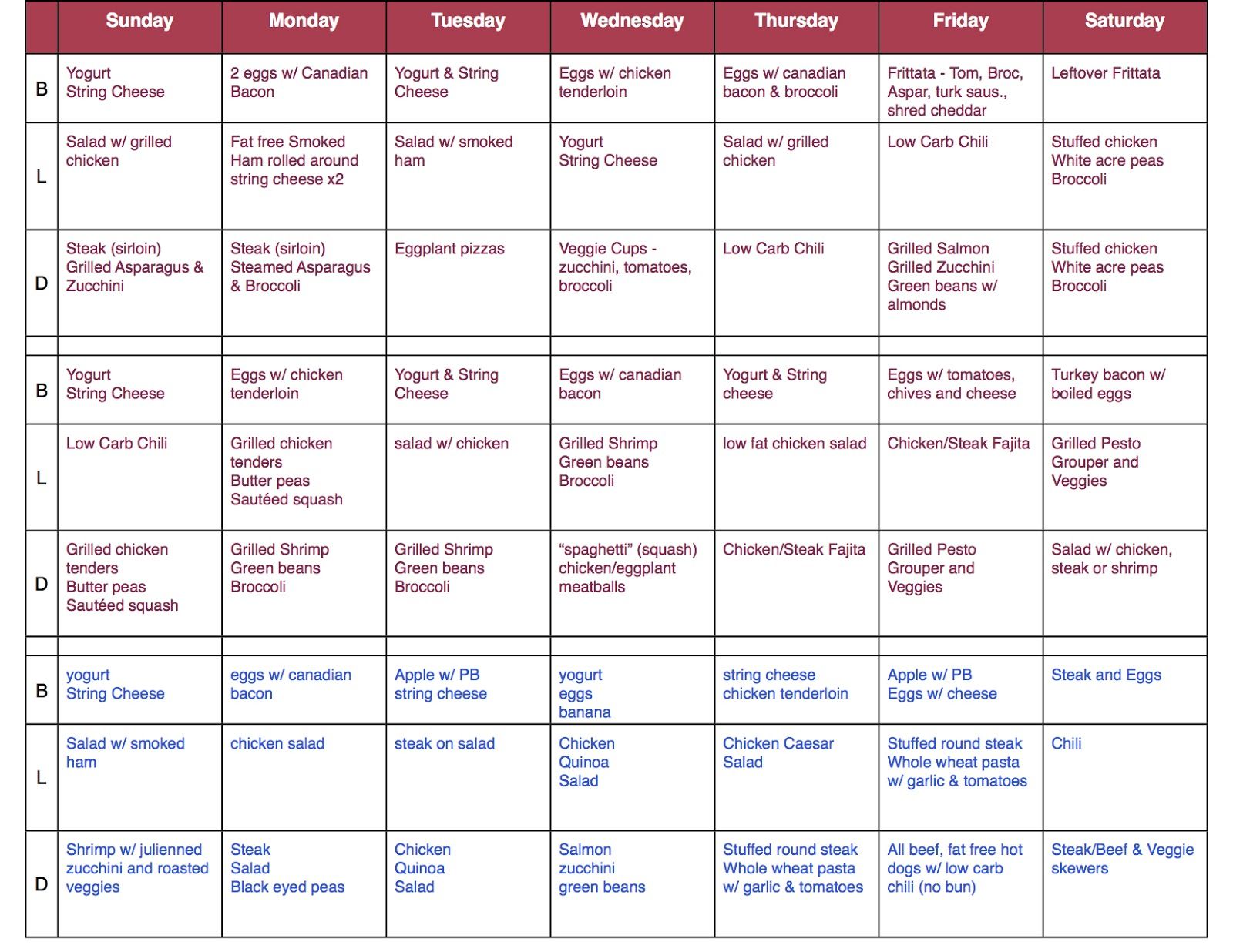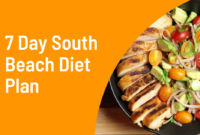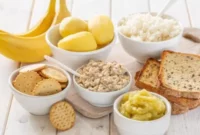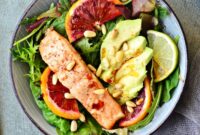South Beach Diet Phase 1 Sample Menu: Embark on a culinary journey through this introductory guide to the first phase of the popular South Beach Diet. We’ll explore the core principles, permitted and restricted foods, and delve into a detailed 7-day sample menu designed to kickstart your weight loss and improve your overall health. This phase emphasizes lean proteins, healthy fats, and non-starchy vegetables, while temporarily restricting sugary foods and refined carbohydrates. Understanding the rationale behind these restrictions is crucial for success and long-term adherence to the diet. Prepare to discover delicious and satisfying meals that align with the South Beach Diet’s philosophy.
This guide provides a comprehensive overview of the South Beach Diet’s Phase 1, including a detailed 7-day sample menu, nutritious recipes, healthy snack options, and strategies to overcome potential challenges. We’ll also compare and contrast this phase with other low-carb diets, offering a balanced perspective on the various approaches available. Whether you’re a seasoned dieter or a curious newcomer, this resource will equip you with the knowledge and tools to navigate Phase 1 successfully.
Overview of the South Beach Diet Phase 1
The South Beach Diet Phase 1 is a rapid weight-loss phase designed to jumpstart weight loss and improve metabolic function by drastically reducing refined carbohydrates and unhealthy fats. This initial phase focuses on stabilizing blood sugar levels and reducing insulin resistance, which are key factors in weight management and overall health. It’s a temporary, highly restrictive phase meant to be followed for approximately two weeks, or until significant weight loss is achieved.
This initial phase emphasizes the consumption of lean proteins, healthy fats, and non-starchy vegetables. The rationale behind the restrictions lies in minimizing the intake of foods that trigger rapid spikes in blood sugar. These spikes lead to insulin release, which can promote fat storage and hinder weight loss efforts. By limiting these trigger foods, the body shifts to burning stored fat for energy.
Allowed and Restricted Food Groups in Phase 1
The South Beach Diet Phase 1 strictly limits or eliminates certain food groups to achieve its weight-loss goals. Understanding these limitations is crucial for successful adherence to the plan.
- Allowed Foods: Lean proteins (fish, poultry, beans, lentils, tofu), healthy fats (olive oil, avocados, nuts, seeds), non-starchy vegetables (broccoli, spinach, asparagus, peppers), and limited amounts of whole grains (such as small portions of oatmeal).
- Restricted Foods: All sugary drinks (soda, juice), most fruits (except berries in limited quantities), refined carbohydrates (white bread, pasta, pastries), processed foods, and unhealthy fats (saturated and trans fats found in fried foods, red meat, and many processed snacks).
Rationale Behind Dietary Restrictions
The restrictions placed on certain foods during Phase 1 are not arbitrary. They are based on the understanding of how different foods impact blood sugar levels and insulin response. The diet aims to:
- Stabilize Blood Sugar: By eliminating refined carbohydrates and sugary foods, the diet prevents the rapid spikes and crashes in blood sugar that lead to hunger and cravings. This helps to control appetite and prevent overeating.
- Reduce Insulin Resistance: High levels of insulin, often a result of consuming refined carbohydrates, can lead to insulin resistance, a condition where the body’s cells become less responsive to insulin’s effects. This resistance makes it harder for the body to use glucose for energy, leading to increased fat storage. The South Beach Diet Phase 1 aims to improve insulin sensitivity.
- Promote Fat Burning: By limiting carbohydrate intake and providing adequate protein and healthy fats, the body is encouraged to utilize stored fat for energy, leading to weight loss.
Sample Menu Creation for Phase 1
This section provides a 7-day sample menu for the South Beach Diet Phase 1, highlighting the nutritional content of each meal. Remember to adjust portion sizes to meet your individual caloric needs and consult with a healthcare professional before making significant dietary changes. The focus is on lean protein, healthy fats, and non-starchy vegetables.
The following menu emphasizes the principles of the South Beach Diet Phase 1 by limiting sugary and processed foods while incorporating plenty of protein and healthy fats to keep you feeling full and satisfied. Each day’s meals are designed to be balanced and nutritious, providing a variety of flavors and textures to prevent dietary boredom.
Seven-Day Sample Menu for South Beach Diet Phase 1
This table presents a sample 7-day menu plan adhering to the South Beach Diet Phase 1 guidelines. Note that snacks should be chosen from the allowed foods within Phase 1, and portion sizes may need adjustment based on individual caloric needs and activity levels.
| Day | Breakfast | Lunch | Dinner | Snacks |
|---|---|---|---|---|
| Monday | 3-egg omelet with spinach and mushrooms | Grilled chicken salad with mixed greens, avocado, and a vinaigrette dressing | Baked salmon with asparagus and a side of quinoa | Handful of almonds, celery sticks with peanut butter |
| Tuesday | Greek yogurt with berries and a sprinkle of chia seeds | Tuna salad (made with avocado mayo) on a bed of lettuce | Lean ground beef stir-fry with broccoli and bell peppers | Hard-boiled egg, small portion of cottage cheese |
| Wednesday | Scrambled eggs with chopped tomatoes and onions | Leftover lean ground beef stir-fry | Chicken breast with roasted Brussels sprouts and a small sweet potato | String cheese, a few slices of cucumber |
| Thursday | Smoked salmon and cream cheese on whole-wheat toast (limited amount) | Large salad with grilled shrimp and a lemon vinaigrette | Pork tenderloin with green beans and a side salad | Brazil nuts, a small portion of hummus with carrot sticks |
| Friday | Greek yogurt with berries and a sprinkle of almonds | Leftover pork tenderloin and green beans | Baked cod with steamed broccoli and cauliflower | Plain yogurt, a small portion of olives |
| Saturday | Omelet with cheese, mushrooms and peppers | Chicken salad (made with avocado mayo) lettuce wraps | Steak with a side of spinach salad | Mixed nuts, bell pepper slices |
| Sunday | Scrambled eggs with spinach and feta cheese | Leftover steak and spinach salad | Turkey meatballs with zucchini noodles | Cottage cheese, sliced tomatoes |
Nutritional Content Elaboration
The nutritional content of each meal varies depending on specific ingredients and portion sizes. However, a general overview of the macronutrient sources is provided below. These are examples and should not be considered exact values without precise measurements and ingredient specifications.
Protein Sources: Eggs, chicken breast, salmon, tuna, ground beef, pork tenderloin, cod, turkey meatballs, Greek yogurt, cottage cheese, shrimp. These provide essential amino acids for muscle building and repair.
Carbohydrate Sources: Limited amounts of whole-wheat toast, quinoa, sweet potato, berries, vegetables (such as broccoli, asparagus, Brussels sprouts, green beans, zucchini, spinach, bell peppers, mushrooms, tomatoes, and onions). These are primarily complex carbohydrates that provide sustained energy.
Fat Sources: Avocado, olive oil, nuts (almonds, Brazil nuts), seeds (chia seeds), peanut butter, cream cheese, and the natural fats found in fish and meat. These are predominantly healthy unsaturated fats crucial for hormone production and overall health.
Recipe Ideas for Phase 1 Meals
The South Beach Diet Phase 1 emphasizes lean protein, healthy fats, and non-starchy vegetables. These recipes provide delicious and satisfying meals that adhere to the Phase 1 guidelines, ensuring you stay on track with your dietary goals. They are designed to be both flavorful and easy to prepare.
Mediterranean Tuna Salad
This recipe offers a light yet filling meal, rich in protein and healthy fats. The combination of tuna, avocado, and cucumber creates a refreshing and satisfying flavor profile. The texture is creamy and smooth from the avocado, contrasted by the crispness of the cucumber.
- Ingredients: 1 can (5 ounces) tuna in water, drained; ½ avocado, diced; ½ cucumber, diced; 2 tablespoons chopped red onion; 1 tablespoon lemon juice; 1 tablespoon olive oil; Salt and pepper to taste.
- Instructions: In a medium bowl, combine the tuna, avocado, cucumber, and red onion. In a small bowl, whisk together the lemon juice and olive oil. Pour the dressing over the tuna mixture and gently toss to combine. Season with salt and pepper to taste. Serve immediately or chill for later.
Grilled Chicken and Asparagus
This recipe showcases lean protein and non-starchy vegetables, providing a balanced and nutritious meal. The grilling process adds a smoky flavor to the chicken and asparagus, enhancing their natural tastes. The texture is tender and slightly charred from the grill.
- Ingredients: 4 boneless, skinless chicken breasts; 1 pound asparagus, trimmed; 1 tablespoon olive oil; 1 teaspoon garlic powder; ½ teaspoon onion powder; Salt and pepper to taste.
- Instructions: Preheat grill to medium-high heat. In a bowl, toss the asparagus with 1/2 tablespoon olive oil, salt, and pepper. In a separate bowl, toss the chicken breasts with the remaining olive oil, garlic powder, onion powder, salt, and pepper. Grill the asparagus for 5-7 minutes, turning occasionally, until tender-crisp. Grill the chicken for 6-8 minutes per side, or until cooked through. Serve immediately.
Shrimp Scampi with Zucchini Noodles
This recipe offers a low-carb alternative to traditional scampi, using zucchini noodles instead of pasta. The shrimp provides lean protein, while the zucchini noodles offer a light and refreshing base. The flavor profile is savory and slightly garlicky, with a hint of lemon. The texture is delicate and slightly firm from the zucchini noodles, perfectly complementing the tender shrimp.
- Ingredients: 1 pound shrimp, peeled and deveined; 2 medium zucchini, spiralized or julienned; 2 tablespoons olive oil; 2 cloves garlic, minced; ¼ cup dry white wine; 2 tablespoons lemon juice; 2 tablespoons chopped fresh parsley; Salt and pepper to taste.
- Instructions: Heat olive oil in a large skillet over medium heat. Add garlic and cook for 1 minute, until fragrant. Add shrimp and cook for 2-3 minutes per side, until pink and cooked through. Add zucchini noodles and cook for 2-3 minutes, until tender-crisp. Stir in white wine, lemon juice, and parsley. Season with salt and pepper to taste. Serve immediately.
Snack Options for Phase 1
Maintaining healthy blood sugar levels is crucial during Phase 1 of the South Beach Diet, which emphasizes low-glycemic foods. Strategic snacking helps prevent hunger pangs and keeps energy levels stable, preventing you from reaching for less-than-ideal options. Choosing the right snacks can significantly contribute to your overall success on the diet.
The following five snack options are suitable for Phase 1, offering a balance of protein, healthy fats, and fiber to keep you satisfied and support your weight loss goals.
Five Healthy Snack Options for South Beach Diet Phase 1
The selection below considers both nutritional benefits and glycemic index impact. Remember portion control is key, even with healthy snacks.
- Hard-boiled eggs: One or two hard-boiled eggs provide a good source of protein, essential for satiety and muscle maintenance. They are also rich in choline, important for brain health. The glycemic index of eggs is zero, as they don’t contain carbohydrates.
- Small handful of almonds: Almonds are packed with healthy monounsaturated fats, fiber, and vitamin E. These fats contribute to feelings of fullness and help regulate blood sugar levels. The glycemic index of almonds is low. A small handful (about 15-20 almonds) is a recommended serving.
- Greek yogurt (plain, unsweetened): Greek yogurt is a high-protein snack that’s low in carbohydrates. It’s a good source of calcium and probiotics, beneficial for gut health. Choose plain, unsweetened varieties to avoid added sugars. The glycemic index of plain Greek yogurt is low.
- Celery sticks with almond butter: Celery provides fiber and water, contributing to satiety. Almond butter adds healthy fats and protein. The combination offers a balanced snack with a low glycemic index, as both celery and almond butter are low on the glycemic index scale. Be mindful of portion size with almond butter.
- A small avocado: Avocados are rich in healthy monounsaturated fats, fiber, and potassium. These fats help regulate blood sugar and promote feelings of fullness. The glycemic index of avocado is low.
Glycemic Index Comparison of Snacks
The glycemic index (GI) measures how quickly a carbohydrate-containing food raises blood sugar levels. Foods with a low GI are digested and absorbed more slowly, leading to a more gradual and sustained rise in blood sugar. As seen above, many Phase 1 snacks are naturally low-GI or GI-zero due to their low carbohydrate content. This is crucial for maintaining stable blood sugar and avoiding energy crashes.
| Snack | Approximate Glycemic Index |
|---|---|
| Hard-boiled eggs | 0 |
| Almonds | Low |
| Plain Greek Yogurt | Low |
| Celery with Almond Butter | Low |
| Avocado | Low |
Addressing Potential Challenges of Phase 1
Embarking on the South Beach Diet Phase 1 can present certain hurdles. Understanding these common difficulties and implementing effective strategies can significantly improve adherence and success. This section addresses potential challenges and provides practical solutions to navigate them smoothly.
The initial phase of the South Beach Diet, characterized by its restrictive nature, often leads to difficulties. Many individuals experience intense cravings, particularly for sugary and processed foods. Meal preparation can also become time-consuming, especially for those with busy schedules. Furthermore, dietary restrictions or allergies can further complicate the process, necessitating careful meal planning and ingredient substitutions.
Cravings and Hunger Management
Managing cravings is crucial for long-term adherence to the South Beach Diet Phase 1. These cravings are often a result of the sudden elimination of simple carbohydrates and sugars. To mitigate this, focus on increasing your protein and healthy fat intake. Protein promotes satiety, keeping you feeling full and reducing the urge to snack. Healthy fats, such as those found in avocados and nuts, also contribute to satiety and provide sustained energy. Furthermore, staying hydrated by drinking plenty of water can help alleviate hunger pangs and reduce the perception of cravings. Consider incorporating sugar-free chewing gum or sucking on sugar-free hard candies to satisfy oral cravings.
Efficient Meal Preparation and Time Management
The South Beach Diet Phase 1 often requires more time and effort dedicated to meal preparation compared to a less restrictive diet. To overcome this, consider preparing meals in advance. Batch cooking on weekends, for example, can provide healthy meals for the entire week, minimizing daily cooking time. Utilizing simple recipes with minimal ingredients can also simplify the process. Embrace meal prepping techniques such as chopping vegetables and portioning ingredients ahead of time. Additionally, exploring quick and easy recipes, such as salads or grilled fish, can help manage time constraints.
Dietary Restrictions and Allergy Considerations
Individuals with dietary restrictions or allergies may find the South Beach Diet Phase 1 challenging. However, modifications are possible. For example, individuals with gluten intolerance can substitute gluten-free bread and pasta. Those with dairy allergies can use dairy-free alternatives such as almond milk or soy milk. Similarly, individuals with nut allergies can substitute sunflower seeds or pumpkin seeds for nuts in recipes. Always carefully read food labels to ensure ingredients are compliant with the diet and your individual dietary needs. Consulting a registered dietitian or nutritionist can provide personalized guidance on adapting the diet to specific dietary requirements.
Visual Representation of a Phase 1 Meal
A visually appealing Phase 1 South Beach Diet meal is crucial for maintaining adherence and enjoyment. The vibrant colors, varied textures, and thoughtful arrangement contribute significantly to the overall dining experience, making healthy eating feel less like a chore and more like a satisfying culinary adventure. The goal is to create a plate that is both nutritious and aesthetically pleasing.
The visual impact of a Phase 1 meal hinges on the strategic combination of ingredients. Imagine a plate featuring grilled salmon, its pinkish-orange hue contrasting beautifully with the deep green of steamed asparagus and the bright yellow of a small portion of quinoa. The salmon offers a glistening, slightly oily texture, while the asparagus provides a crisp, tender bite, and the quinoa adds a slightly chewy, nutty element. A squeeze of fresh lemon juice adds a touch of brightness, both visually and in terms of flavor, while a scattering of chopped fresh dill provides a pop of color and delicate fragrance. The overall effect is one of freshness, vibrancy, and balance – a harmonious blend of colors and textures that invite the diner to savor each component.
Color Palette and Texture Variety
The color palette of a successful Phase 1 meal is characterized by its natural vibrancy. Avoid muted or processed colors; instead, focus on the bright hues of fresh produce and lean proteins. The textures should be equally diverse, ranging from the firm yet tender bite of grilled chicken or fish to the crispness of vegetables and the subtle chewiness of whole grains. This variety keeps the meal interesting and prevents it from becoming monotonous. A visually engaging plate will typically incorporate at least three different colors and two distinct textures. For example, a plate of baked cod with roasted broccoli and a side of mixed bell peppers (red, yellow, orange) offers a pleasing range of colors and textures. The flaky cod contrasts beautifully with the slightly charred broccoli and the crunchy peppers.
Comparison with Other Low-Carb Diets
The South Beach Diet, particularly its Phase 1, shares similarities with other low-carbohydrate diets like Atkins and Keto, but also presents key distinctions in its approach and restrictions. Understanding these differences is crucial for choosing the diet best suited to individual needs and preferences. This comparison will highlight the similarities and differences in their methodologies, focusing on potential benefits and drawbacks relative to the South Beach Diet Phase 1.
Dietary Approaches and Restrictions
The South Beach Diet Phase 1, Atkins, and Ketogenic diets all significantly restrict carbohydrate intake to induce ketosis (for Keto) or weight loss through reduced caloric intake from carbohydrates. However, they differ in their approach to carbohydrate restriction and the types of carbohydrates permitted. The South Beach Diet Phase 1 emphasizes eliminating simple carbohydrates and processed foods while allowing for moderate consumption of healthy fats and lean proteins. The Atkins diet, in its initial phase, is more restrictive, focusing heavily on protein and severely limiting carbohydrates. The Ketogenic diet aims for a very high fat intake, moderate protein, and extremely low carbohydrate intake to force the body into a state of nutritional ketosis.
Potential Benefits and Drawbacks Compared to South Beach Diet Phase 1
The South Beach Diet Phase 1, with its emphasis on healthy fats and lean proteins, alongside the controlled exclusion of certain carbohydrates, aims for sustainable weight loss and improved metabolic health. This contrasts with the Atkins diet, which can lead to rapid initial weight loss due to fluid loss, but may also result in nutrient deficiencies if not carefully managed. Its strict initial phase can be challenging to maintain long-term. The Ketogenic diet, while effective for weight loss in some individuals, can cause side effects like the “keto flu” (headaches, fatigue, and nausea) in the initial stages and may require careful monitoring of electrolyte balance. Furthermore, the very high fat intake may not be suitable for individuals with pre-existing cardiovascular conditions. In comparison, the South Beach Diet Phase 1 offers a more gradual and potentially sustainable approach to weight management, mitigating some of the potential drawbacks associated with more restrictive low-carb diets. It allows for a wider range of foods, potentially promoting better adherence and long-term success. However, its slower weight loss compared to Atkins or Keto might be a drawback for some individuals seeking rapid results.
Epilogue
Successfully navigating the South Beach Diet Phase 1 requires commitment and understanding. This guide has provided a foundational framework, outlining the dietary principles, a sample menu, recipe ideas, and strategies for overcoming potential hurdles. Remember, consistency and mindful food choices are key to achieving your health goals. By embracing the principles of this diet, focusing on nutrient-rich foods, and staying hydrated, you can set the stage for lasting lifestyle changes and improved well-being. Consult with a healthcare professional before making significant dietary changes.




